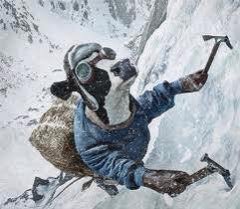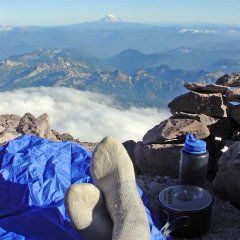Leaderboard
Popular Content
Showing content with the highest reputation on 01/30/20 in all areas
-
Thank you for posting. There was a lot in the write up about Helmy that I didn't know. I'd heard third-hand that Fred referred to him as the smart one for going back to Germany and having a family. Don't know if that true, maybe Megan is around and will chime in. Helmy, Fred, Dee, et al were real trailblazers and true adventurers in the Cascades. Having completed new routes on Johannnesberg, Formidable, and Little Tahoma, I can say that going where no one has been before, where there is no description or cairn or tat, etc. is a very different experience. And in those cases we followed an established route down. What they did in terms of first summits with far less road access...man, that's an order of magnitude more commitment. Cheers to them all, and thank you for blazing those trails and routes that so many have joyfully followed.1 point
-
i may catch grief for this but old ropes are fine for glacier travel. even if they are a bit static-y. the nature of glacier falls is such that the rope cutting into snow takes a bunch of the forces and makes the rope seem dynamic. I am not suggesting to use a static rope like back in the DAY, but an old rope that has lost some stretchiness is not a big deal.1 point
-
yup to DPS. 50m x 8-ish (whatever on sale) mm rope is great for glacier travel. 60m is kinda long and if there are 5 people in group, bring two ropes.1 point
-
I totally agree with Gene. Long rappels in the Cascades are tough due to the ledgy, vegetated nature of the climbing here. 50 is plenty, and rarely come up short while leading, and like Gene said you can always simu-climb. needto climbalso made a good point: "You also have a lot of experience to go with a 50m so can "go back" to it. Trying to give the guy advice so he only needs one rope and not having to worry about if his 50m rope is long enough to get him down on routes that are mainly put up with 60's now days. " I do have experience, and no fewer than six ropes at this moment. There is no one ideal boot or pack for all objectives. Climbers will ultimately end up owning different footwear and packs for the wide variety of climbs they will encounter. Ropes are similar. The OP wants a rope to climb Mt. Baker. 50m in an 8ish mm diameter is a great choice. If the OP wants to take up rock climbing, as in cragging, I agree a 60 meter, ~10 mm, single rope would be better suited. FYIY, 8.5 mm is my choice as well, in Edelweiss, Sharp, Everdry 50 meters. Had to special order them from Pro Mountain Sports, but they are totally worth what they cost. They are probably 11 years old, well past their freshness date. I should retire them, after all I have a fresh pair still in plastic. Anybody have use for two, 50 meter dry half ropes, one green, one purple? Rug art? Tire swing? Tie lumber down in the back of your pickup? I would personally still climb on them, especially just for glacier travel, but at 11 years old (never been set on the ground, never fallen on, stored in a giant plastic bin), I can't endorse anyone doing the same. The purple one is considerably newer with much less mileage, maybe joecav is interested in a donor for glacier routes, free of course.1 point
-
Just saying that most newer routes are put up with 60m ropes. Steve House and Vince Anderson are in a different class than someone who has taken one course and it asking about his first rope. You also have a lot of experience to go with a 50m so can "go back" to it. Trying to give the guy advice so he only needs one rope and not having to worry about if his 50m rope is long enough to get him down on routes that are mainly put up with 60's now days. I'd rather see someone new carry a little bit extra weight than rappel off the ends of their rope or have to simul-climb a bit. With experience comes the ability to go lighter and faster. "Worthless" may have been a bad choice of words though. A 50m isn't worthless, you just need to know when to use it. In this case, based on his question, he doesn't have the experience yet when to use it other than glacier travel. A 60 is simply more versatile for one all-around rope is all I am saying. I would recommend if you are going to get one rope to start with for multitude different climbing styles, it would be one 60m mid 9mm rope. It will do glacier, alpine and cragging. For only glacier, a 50m, 8.5 would be my choice. On my 8.2mm, prusiks suck in trying to get bite but the Sterling Autoblocks work great and grab very well. Microtraxion also grabs the 8.2. Perfect world for me (The diameter listed below is a ballpark.) 40M 8mm glacier rope for two or three man travel on smaller glaciers. It would also work for ski mountaineering or scramble routes where you are not sure if you will need a rope, but want one in your back just in case. Double 60m 8mm ropes for wandering alpine routes or double-rope rappels are mandatory. Use one for larger glacier parties or where crevasses are bigger (Rainier.) 60m 9.5mm for alpine routes where single rope rappels will get you down and for shorter crags. 70m 9.8mm for longer cragging routes This I did not now about diameters being off. Thanks. I also started when a 50 was all I could buy. Then 60's, now 70's and even 80's. When is the madness going to stop? Who the heck wants to carry an 80 meter rope?1 point
-
This reminds me of the guy who wrote that Petzl Aztars can only climb WI 3, when my partners and I were climbing WI-5 with completely straight shafted tools 25 years ago. Similarly, I have to disagree with the notion that 50 meter ropes are worthless in the alpine. When I started climbing 50 meter ropes were all you could buy. When 60 meter ropes came out, I jumped on board. 60 meters is still my go to length for cragging. For alpine climbing I went back to 50 meter ropes and I know a number of very strong, experienced guides and climbers who have done the same. Steve House and Vince Anderson climbed AND DESCENDED the Rupal Face with one 50 meter half rope and one 55 meter, 5.5mm tag line. A 50 meter 8-9 mm rope will be a very versatile rope for glaciers as well as for alpine climbing, ice climbing, alpine rock climbing when used with a second rope. Compare ropes using the weight in grams/meter rather than by diameter. Rope manufacturers fudge the advertised diameter by 0.2 mm (that 9.8 mm rope may actually be 10 mm), but cannot fudge the weight. Also, a really thin rope may seem like a great way to save weight, but don't go too thin or it will be harder to ascend and haul on.1 point
-
I use one an 8.2mm dry rope for all my glacier travel. 60m long. It is 60m as it is part of my double ropes for alpine climbing. It weighs 5.5 lbs. I could chop it to 40 meters and save 2 pounds, but then I would need to buy another rope for my doubles. I don't mind the 60 as that lets me put 3-4 people on the rope with some room on the ends. When I go with just one person, each of us has enough coils to perform a rescue. Remember that for a two-man team, each person needs coils that are just longer than the span between them to be able to drop the other end down. You will see a lot of two-man, and three-man teams tied into the ends of a short rope but that gives them nothing extra for rescue. 50m would be long enough for a 2-3 man as well. 50m is almost worthless rock climbing or in the alpine though as most routes are 60. Your 50m rope would be dedicated only to glacier, while a 60 can do both. Also, if you get into where you cross glaciers then onto rock, a thin rope can be folded over and then used as a double for the rock climb if the pitches are short or you are simulclimbing.1 point
-
Trip: HOOD - Coe Glacier Icefall Date: 5/11/2013 Trip Report: OlegV and I climbed the rarely visited Coe glacier Icefall on the north side of Hood in two rounds for full measure. 10/05/2012 On a nice day in early October, we started at the Cloud Cap and took the around Hood trail #600 towards the beautiful Elk Cove. 5 min from the parking lot, the trail ended in cliffed out banks of the Eliot creek, not producing much confidence after the 2006’ washout. After rapping down in the creek, Oleg, a brave soul, “led” aka free soloed the other side with precariously hanging boulders to the top of west Eliot morain. Eliot Creek crossing was very enjoyable and certainly a highlight of the entire trip: Yep, don’t do it: Oleg on the trail #600: After reaching west lateral morain of Languille gl., we cut south towards the Coe: And dropped down on Coe @ OV2 (7400’): Things on Coe were looking good and as expected: bullet-proof alpine ice and holes everywhere. After reaching the lower icefall, we pitched in the tent in protected spot which was a job on its own: [video:vimeo]50950067 As always, Hood made its own fancy clouds at sunset: Next morning we packed up and headed up trying to get through barricades to the shelf leading to the Snow Dome which was not happening as fast as it should had: The higher we got the more we were finding ourselves surrounded by bottomless abysses. Ice features were more intricate than on Price: With the lack of upward progress, we called it quits somewhere in the middle of icefall and made our way down on the endless V-threads. The chess game. We lost it this time: Eliot Creek crossing followed. 05/11/2013 With the Cloud Cap road still being closed, we settled on the standard approach via Snow Dome given in Ore High. Due to different work schedules, we started separately at the Tilly Jane TH @ 3800’. While Oleg was getting off work, I uneventfully hiked to the Snow Dome @ 9100’ and pitched in the tent by the shrund. North Face is thin, but in. The shrund is wall-to-wall, so take you chances. Oleg emerging on the Snow Dome: At the camp: Next morning we slogged down to the notch marking the start of the famous “crappy gully” and downclimbed 1000’ to the Coe below the hanging icecliffs: The traverse to the middle of the glacier was sketchy. Here it is where you’ve got to sprint across the obvious runway made by objects falling off the hanging icecliffs. When we thought we were in the safe spot, Oleg punched through the crevasse but climbed out of it. For some bizarre reason, I followed his example and ended up in the same crevasse after another bridge failed. Happy to get up on the solid ground: Lower Coe icefall: We rope soloed the entire route as it was in more straightforward shape than back in October. Kind of disappointing, really. Approaching the upper Coe: Upper Coe: Jumping over more crevasses: Oleg on the Cathedral ridge: Oleg on the summit ridge: We descended the Cathedral ridge to the shelf splitting the lower and upper Coe. Getting down to the Coe was tricky as you gotta jump through the moat: On the final slog towards the Snow Dome: Gear Notes: Screws and 2 pickets Approach Notes: Trail 600 or Snow Dome1 point




